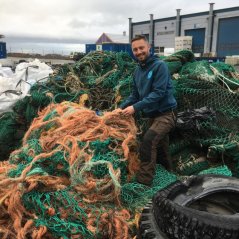
News
Fishing net litter on beaches: what can be done to prevent this?
Abandoned, lost or otherwise discarded fishing nets floating around at sea and washing up on beaches in the Arctic and North-East Atlantic Ocean regions are a persistent problem. Based on the findings of a new study by Wageningen University & Research into the sources and pathways of such litter, it was found that most can be prevented by improving waste management practices on board bottom trawling vessels.
In many areas, the sources and pathways of fishing net litter on beaches are unknown. This makes it challenging to understand and to effectively address the issue. Therefore, a new analysis tool was developed by Wageningen University & Research to further investigate the sources and pathways of such litter.
Most fishing nets on beaches are mismanaged net cuttings

With the help of local fishing gear experts, 211 large pieces of trawl net (>50 cm) along with 2,908 smaller pieces were examined that had been collected during beach clean-ups in West-Greenland, Iceland, Jan Mayen, Svalbard, Norway, the Netherlands, and Scotland.
By systematically examining aspects such as the mesh size, cut and tear marks and other clues, the research team discovered that fishing net litter that washes up on beaches does not comprise of complete nets, often referred to as ‘lost gear’, but instead of bits and pieces of nets, most of which are used in bottom trawl fisheries. It was also found that most of those pieces are the result of damage during trawling, and, predominantly, the mismanagement of net cuttings during mending on deck. If not properly collected and disposed of, net cuttings may end up in the sea by being swept overboard or discarded.
Researcher Wouter Jan Strietman: “Based on our findings, we concluded that the most effective mitigation measure to prevent such litter from ending up in the sea is to further improve collection and disposal procedures of net cutting waste on board of bottom trawling vessels and provide viable port side disposal facilities for these materials. This would significantly reduce such fishing net litter on beaches in the future”.
Improve fishing net waste management to reduce safety risks to shipping

Since some of the pieces were very large, the issue of fishing net waste mismanagement also represents a serious navigational hazard for ships and fishing vessels, particularly the danger of fouled propellers. This can render ships unmanageable and endanger the crew and passengers. The risks involved and the potential environmental consequences (e.g. oil spills) are extended further when considering the areas of study.
“The further North cruise vessels, cargo vessels, and fishing vessels travel, the more vulnerable the environment is, the more remote the area is, and therefore the greater the difficulty is for search and rescue operations to take place. Since fishing activity in Arctic waters has increased in recent years, improved collection and disposal procedures of fishing net waste would significantly improve safety of navigation for vessels operating in the region”, according to Strietman.
Providing input to other initiatives
Throughout the last decade, many initiatives have sprung up to address the issue of abandoned, lost or otherwise discarded fishing gear (ALDFG). Within this context, important progress has been made by the fishing industry, individual States, NGOs such as the Global Ghost Gear Initiative, and international organisations such as OSPAR, the EU, IMO, the Arctic Council, the Nordic Council of Ministers and the FAO. The report’s findings and recommendations will contribute to such on-going initiatives or may provide inspiration for new ones.